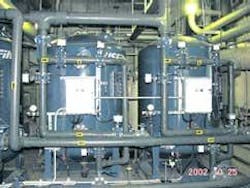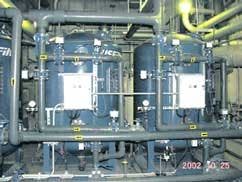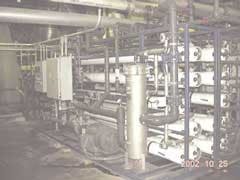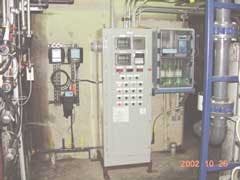RO System Improves Performance of Three Bed Ion Exchange Demineralizer
By James R. Holland Jr.
In a move to reduce costs and improve the quality of boiler feedwater, single-pass reverse osmosis units were installed ahead of three-bed ion exchange demineralizers at an electric power plant consisting of three supercritical, coal fired steam generators, supplying turbo generators with a gross capacity of 1920 MW.
The retrofit was considered because of increasing demands for high quality boiler feedwater and the need to minimize cost of the feedwater. Three-bed demineralizers historically have high maintenance costs, mostly associated with the regeneration systems and the degradation of ion exchange resins due to repeated regeneration.
An economic analysis indicated that the high capital cost of the RO installation would be offset by reduced costs associated with the three-bed demineralizer. The RO would supply feed water of a higher quality, thereby increasing the volume of water treated prior to the exhaustion of the ion exchange resin. Regeneration frequency, chemical usage and treatment of the regeneration wastewater would all be reduced.
Initial estimates indicated that the RO system would result in a 10-fold increase in throughput capacity of the three-bed demineralizer before regeneration. Based on that estimate, an attractive pay back and internal rate of return would be realized, so the installation proceeded.
The existing throughput capacity of the two three-bed demineralizers averaged 250,000 gallons. After several months of operation with the RO retrofit, the three-bed demineralizers were producing 2.5 million gallons prior to regeneration, meeting initial expectations.
However, based on chemical analysis and modeling using Dow Chemical Company's CADIX (Computer Aided Design for Ion Exchange Systems) software, it was predicted that the system could yield a 6.7 million gallon throughput capacity with additional changes in the treatment system. System upgrades are underway to reach that goal.
RO project
The Cardinal power plant is jointly owned by American Electric Power, an investor-owned utility, and Buckeye Power Company, a member-owned organization of rural electric cooperatives. The plant encompasses three separate coal fired steam generating units located on a 500-acre site along the Ohio River near Brilliant, OH.
The plant uses two three-bed demineralizers, consisting of a cation exchanger, weak base exchanger, strong base exchanger and polishing mix bed. Each three-bed demineralizer has a rated flow of 250 gpm. Untreated make-up water is drawn from a river, which has severe swings in both temperature and turbidity. The river water is treated by a conventional surface water pretreatment plant consisting of solids contact clarification, gravity anthracite filtration, and pressure carbon filtration. Bleach is fed as a biocide and a cationic polymer is fed as a coagulant.
Two single pass RO units were retrofitted, each supplying one of the three-bed demineralizers. A 220 gpm flow rate was chosen for each RO design basis. The RO units operate at 75 percent recovery, with a 98 percent salt rejection. The existing feed to the three-bed demineralizer averaged 350 mmho specific conductance. A reduction to less than 10 mmho was expected by the single pass RO.
Silt density index was measured at the existing carbon filter effluent and found to be greater than 5.0. The decision was made to install multimedia filters after the carbon filters and ahead of the RO to reduce SDI to less than 2.0.
Three multimedia filters were used, each having a design flow rate of 300 gpm. This would allow the operation of both ROs and three-bed demineralizers with two filters in service, the third being out of service for backwash or maintenance.
Three chemical feed skids were installed; bleach feed for membrane disinfection, sodium bisulfite feed for dechlorination, and an antiscalant feed to prevent membrane fouling. A clean in place system was also installed consisting of a tank with a heater, pump and filter. This would allow cleaning of the RO membranes without removal of the elements.
Initial Operation
Initial start-up of the RO went well with few difficulties encountered. After six months of operation, the three-bed demineralizers were averaging approximately 2.5 million gallons per run, meeting the design expectations and confirming the economics of the installation.
However, the demineralizers were operating in a base-limited capacity. Silica break at the strong anion outlet limited the quantity of demineralized water produced.
The projected permeate analysis, based upon the feed analysis, was calculated using Dow Chemical Company's ROSA (Reverse Osmosis System Analysis) software, Version 4.3.0. The ROSA projection pointed to carbonic acid as the major contaminant in the RO permeate. The permeate projection from ROSA was used as the feed analysis in CADIX, which predicted that the throughput volume to exhaustion of the strong base resin should be 6.7 million gallons. The three-bed was producing substantially less than this, so it was assumed that the carbonic acid concentration had to be much higher than the design estimate.
A chemical analysis of the three-bed demineralizer before and after the RO retrofit revealed that free mineral acidity decreased from 187.38 to 1.04. A pH analyzer installed on the RO feed indicated an average pH of 7.1, well below the 7.5 used for design, thereby explaining the higher than expected concentration of carbonic acid. Several field measurements of the CO2 concentration were made and indicated that the CO2 was running greater than 10 ppm.
Weak Base Resin Replacement
Based upon the free mineral acidity being much less at the cation unit outlet, the benefits of the weak base resin were much lower after the RO retrofit. Weak base resin usually follows strong acid cation exchange units for the purpose of removing the mineral acidity formed. Weak base capacity for removing mineral acidity is usually very high, and regeneration efficiency is also very high for this type of resin. The weak base resin also performs another important function in three-bed operation: the removal of organics prior to strong base resin, which is easily fouled by organic contaminants. Organics are less tightly bound by weak base resin and easily removed during regeneration.
The three primary considerations for replacing the weak base after RO retrofit was:
• Low mineral acidity of the cation unit effluent.
• The need to have additional CO2 removal capacity.
• The reduced organic loading to the three-bed.
The weak base resin (160 ft3 Dow Marathon WBA) was removed from the weak base unit and replaced with 90 ft3 of DOW SBR strong base resin. This doubled the strong base capacity of the three-bed. Regeneration flow rates and caustic dosage were recalculated, and these changes were applied to accommodate the new resin scheme.
The throughput prior to exhaustion increased from 2.5 million gallons to 4 million gallons by the addition of the resin. Based on these results an additional 70 ft3 of strong base resin is scheduled to be added to the weak base exchanger. The throughput is expected to increase by a corresponding amount and approach the 6.7 million gallon capacity predicted by CADIX.
A word of caution, if catastrophic failure of the RO would occur, what would be the capacity of the three-bed with no weak base and being supplied from the carbon filters? According to a CADIX scenario, the throughput would be limited to 150,000 gallons. A certain amount of risk was assumed when replacing the weak base with strong base resin.
Additional Changes
Plans are to add an additional 70 ft3 of strong base resin to the weak base unit. More anion elution studies will follow to ensure proper regeneration. A chemical feed system to adjust the pH of the RO feed is also being considered. pH will be controlled at approximately 8.5 to convert CO2 to HCO3 and CO3, which is easily rejected by the membranes. CO2 concentration versus pH was run using HSC Chemistry, to determine the optimum pH for CO2 conversion. Operating under this condition increases risk for membrane fouling and thus antiscalant feed will have to be carefully monitored.
Conclusions
The retrofit of a single pass RO ahead of a three-bed ion exchange demineralizer is financially attractive; the savings realized in operation and maintenance expense easily offsets the large capital cost of the RO. Care must be taken in the optimization of the system. A process pH analyzer on the proposed feed for a RO is invaluable. The determination of alkalinity and pH on grab samples are inaccurate, a closed carbonate system becomes an open system when the sample is handled, and equilibration with atmospheric gases is unavoidable. Design prediction calculations should be determined using CADIX and ROSA each time a change is made to the system.
About the Author: James R. Holland Jr. is a Senior Chemical Engineer with American Electric Power Pro Serv in the Combustion and Air Pollution Control Engineering Section. AEP operates and maintains more than 38,000 megawatts of coal, gas, hydro and nuclear generating capacity. Holland has more than 25 years experience with AEP in engineering and energy production. This article is based on Holland's paper "The Retrofit of a Single Pass RO Ahead of a Conventional Three Bed Ion Exchange Demineralizer in Large Utility Power Plants." The paper will be presented at the Industrial Water Conference, set for Dec. 10-11 in Orlando, FL.



